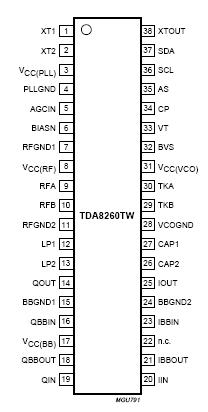TDA8260TW: Features: · Direct conversion Quadrature Phase Shift Keying (QPSK) and 8-Phase Shift Keying (8PSK) demodulation (Zero-IF)· Frequency range: 950 to 2175 MHz· High level asymmetrical RF input· 0 to 50...
floor Price/Ceiling Price
- Part Number:
- TDA8260TW
- Supply Ability:
- 5000
Price Break
- Qty
- 1~5000
- Unit Price
- Negotiable
- Processing time
- 15 Days
SeekIC Buyer Protection PLUS - newly updated for 2013!
- Escrow Protection.
- Guaranteed refunds.
- Secure payments.
- Learn more >>
Month Sales
268 Transactions
Payment Methods
All payment methods are secure and covered by SeekIC Buyer Protection PLUS.

 TDA8260TW Data Sheet
TDA8260TW Data Sheet







